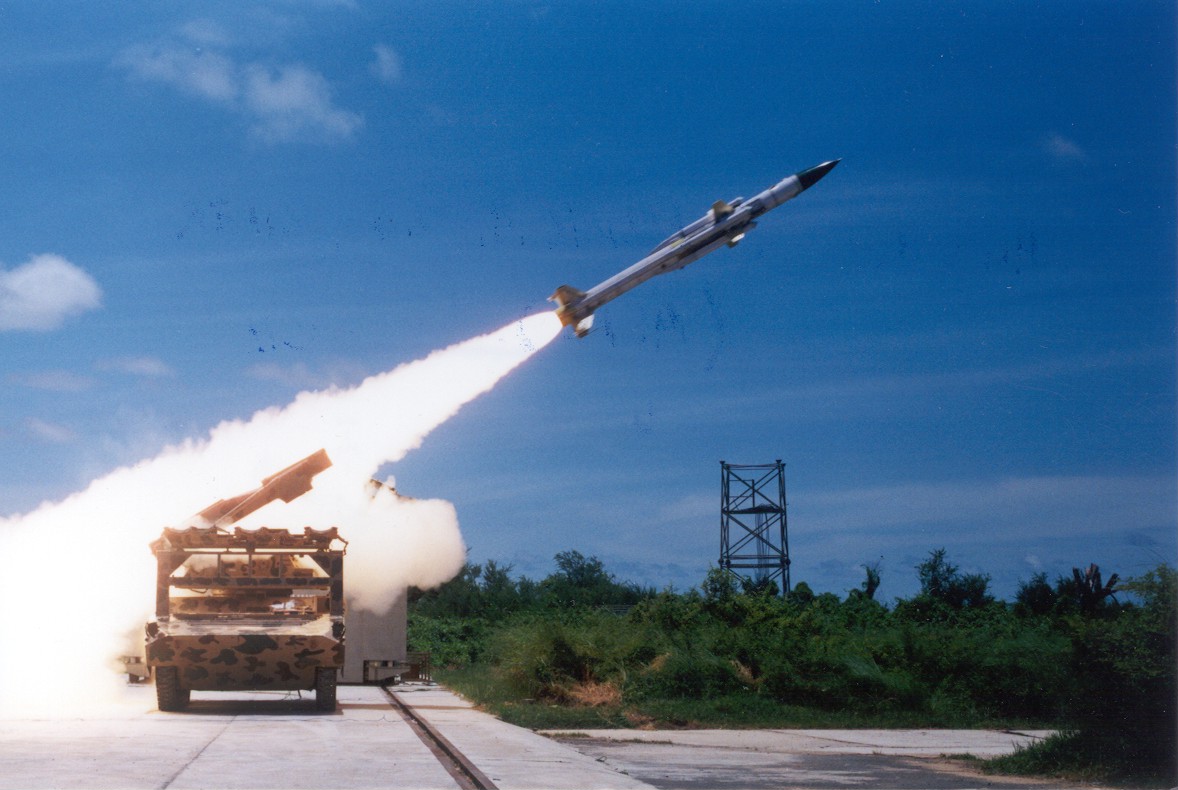Akash Air Defence system

Akash uses state of the art integral ramjet rocket propulsion system to give a low-volume, low-weight (700 kg launch weight) missile configuration, and has a low reaction time - from detection to missile launch - of 15 seconds allowing the missile to carry a heavier 60 kg fragmentation warhead triggered by proximity fuse.
Theoretically, a “ripple” of two Akash missiles has a 99 per cent chance of shooting down a modern fighter aircraft.
It reaches a speed of Mach 1.5 in 4.5 seconds Mach. 2.8-3.5 at 20g in 30 seconds after ramjet motor is ignited. Its range (for most effective performance) varies 27-30 kilometres.
5.6 m long sleek missile has a launch weight of 700 kg and can carry 60 kg of warhead and the radar is capable of tracking 64 targets and guide upto 12 missiles simultaneously in a fully autonomous mode of operation.
The Akash is to bepurchased by the Indian air defence command and is for sale to customers abroad.
successfully tested it more than 45 times the DRDO is confident that Akash will be effective against low-flying missiles, aircraft and unmanned aerial vehicles.
Unlike the Patriot, can be launched from static or mobile platforms, including a battle tank.
What makes it superior to Patriot, apart from the mobility of its platform, is that it has thrust during the entire course of its 35-second flight. Patriot has thrust only for 12 seconds, after which the missile coasts, thus making it less accurate than Akash.

One Akash battery is composed of three tracked vehicles (tracks, like those on a battle tank), each of which would have four missiles, plus a vehicle carrying the Rajendra multifunction phased array radar. The Air Force version is on wheeled vehicles.
The missile can be deployed either in autonomous mode or group mode. In the autonomous mode, it will have a single battery functioning independently. For surveillance, it would need an additional two-dimensional radar. In this mode, it can be used for defending moving columns or singular installations. A single battery can simultaneously engage four targets, and against each target a maximum of three missiles can be fired, thus increasing the hit probability.
In group mode, there would be a number of batteries, deployed over a wide area. The batteries would be linked to a group control centre (GCC). The Rajendra three-dimensional radar, indegenously developed by the DRDO (defence Research & Development Organisation) would provide a single integrated air picture to the group control centre, telling it not only the distance at which the enemy plane has been located but also its altitude. One GCC can command and control a maximum of eight Akash batteries at the same time. One GCC can also receive radar surveillance information from other sources, and be linked to higher echelons of air defence. Once the target, either an enemy aircraft or a missile, is detected the missile would align to the radar beams and virtually travel on those beams (guided by onboard precision-homing system) towards the target at three-and-a-half times the speed of sound.
The DRDO is reportedly toying with the idea of developing an integrated missile shield, which would be able to cover an area of at least 200 sq. km in the next five to six years. Akash, or the technologies developed for Akash, would be at the heart of the system. Its radars could be placed on a civil aircraft, much like an AWACS system, to provide early warning of incoming missiles.Current development include a possible increase in speed, maximum altitude and range.
The Akash, at 0.26 million $, is cheaper than Patriot, and with Bharat Dynamics willing to manufacture it, there should not be a problem of service support. something which the Americans, given their history of imposing sanctions, may not be able to guarantee.
The Army's radar and launchers are based on the T-72 '' chassis'' to accompany the Army's fast moving armoured formations.


While Air Force versions use a combination of tracked and wheeled vehicle.


India eyes 'Patriot missile'
India could be poised to sign a multi billion dollar arms deal with the United States to purchase patriot missiles. Before Prime Minister Manmohan Singh's meeting with US President Barack Obama, the Indian Army has requested for a briefing of the Patriot-3 Anti-Missile System.
India's air defence systems will include Akash SAM, S-300 , SPYDER, Barak-8, AAD/PAD and hopefully PAC-3 providing a very potent list of Air Defence systems.

Akash missile multi-target area defense capability.

No comments:
Post a Comment